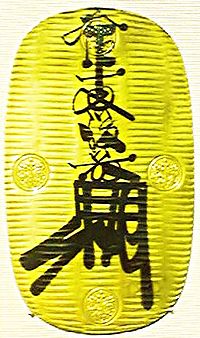
Ryo (currency)
Encyclopedia

- For other meanings with or without the long "ō", see "ryoRyoRyo may refer to:* The Japanese kana digraph ryo, ryō, or ryoh * Ryō , a gold piece in pre-Meiji era Japan worth about sixty monme or four kan...
".
A was a gold
Gold
Gold is a chemical element with the symbol Au and an atomic number of 79. Gold is a dense, soft, shiny, malleable and ductile metal. Pure gold has a bright yellow color and luster traditionally considered attractive, which it maintains without oxidizing in air or water. Chemically, gold is a...
piece in pre-Meiji
Meiji period
The , also known as the Meiji era, is a Japanese era which extended from September 1868 through July 1912. This period represents the first half of the Empire of Japan.- Meiji Restoration and the emperor :...
Japan
Japan
Japan is an island nation in East Asia. Located in the Pacific Ocean, it lies to the east of the Sea of Japan, China, North Korea, South Korea and Russia, stretching from the Sea of Okhotsk in the north to the East China Sea and Taiwan in the south...
. It was worth about sixty monme of silver
Silver
Silver is a metallic chemical element with the chemical symbol Ag and atomic number 47. A soft, white, lustrous transition metal, it has the highest electrical conductivity of any element and the highest thermal conductivity of any metal...
or four kan (4,000 coins) of copper
Copper
Copper is a chemical element with the symbol Cu and atomic number 29. It is a ductile metal with very high thermal and electrical conductivity. Pure copper is soft and malleable; an exposed surface has a reddish-orange tarnish...
(the exchange rate fluctuated). It was eventually replaced with a system based on the yen
Japanese yen
The is the official currency of Japan. It is the third most traded currency in the foreign exchange market after the United States dollar and the euro. It is also widely used as a reserve currency after the U.S. dollar, the euro and the pound sterling...
.
The ryō was originally a unit of weight from China
China
Chinese civilization may refer to:* China for more general discussion of the country.* Chinese culture* Greater China, the transnational community of ethnic Chinese.* History of China* Sinosphere, the area historically affected by Chinese culture...
, the tael
Tael
Tael can refer to any one of several weight measures of the Far East. Most commonly, it refers to the Chinese tael, a part of the Chinese system of weights and currency....
. It came into use in Japan during the Kamakura period
Kamakura period
The is a period of Japanese history that marks the governance by the Kamakura Shogunate, officially established in 1192 in Kamakura by the first shogun Minamoto no Yoritomo....
. By the Azuchi-Momoyama period
Azuchi-Momoyama period
The came at the end of the Warring States Period in Japan, when the political unification that preceded the establishment of the Tokugawa shogunate took place. It spans the years from approximately 1573 to 1603, during which time Oda Nobunaga and his successor, Toyotomi Hideyoshi, imposed order...
it had become nearly uniform throughout Japan, about 4.4 monme as a unit of weight (about the same as 16.5 g
Kilogram
The kilogram or kilogramme , also known as the kilo, is the base unit of mass in the International System of Units and is defined as being equal to the mass of the International Prototype Kilogram , which is almost exactly equal to the mass of one liter of water...
). The Keichō
Keicho
was a after Bunroku and before Genna. This period spanned from October 1596 to July 1615. The reigning emperors were and .-Change of era:* 1596 : The era name was changed to Keichō to mark the passing of various natural disasters...
koban
Koban (Japanese gold coin)
The was a Japanese oval gold coin in Edo period feudal Japan, equal to one ryō, another early Japanese monetary unit. It was a central part of Tokugawa coinage....
, a gold
Gold
Gold is a chemical element with the symbol Au and an atomic number of 79. Gold is a dense, soft, shiny, malleable and ductile metal. Pure gold has a bright yellow color and luster traditionally considered attractive, which it maintains without oxidizing in air or water. Chemically, gold is a...
piece, contained about one ryō of gold, so that koban carried a face value of one ryō. However, successive mintings
Mint (coin)
A mint is an industrial facility which manufactures coins for currency.The history of mints correlates closely with the history of coins. One difference is that the history of the mint is usually closely tied to the political situation of an era...
of the koban had varying (usually diminishing) amounts of gold (debasement
Debasement
Debasement is the practice of lowering the value of currency. It is particularly used in connection with commodity money such as gold or silver coins...
). As a result, the ryō as a unit of weight of gold and the ryō as the face value of the koban were no longer synonymous.
See also
- TaelTaelTael can refer to any one of several weight measures of the Far East. Most commonly, it refers to the Chinese tael, a part of the Chinese system of weights and currency....
- Japanese mon (currency)
- WadōkaichinWadokaichin, also romanized as Wadō-kaichin or called Wadō-kaihō, is the oldest official Japanese coinage, having been minted starting in 708 AD on order of Empress Gemmei.-Description:...

